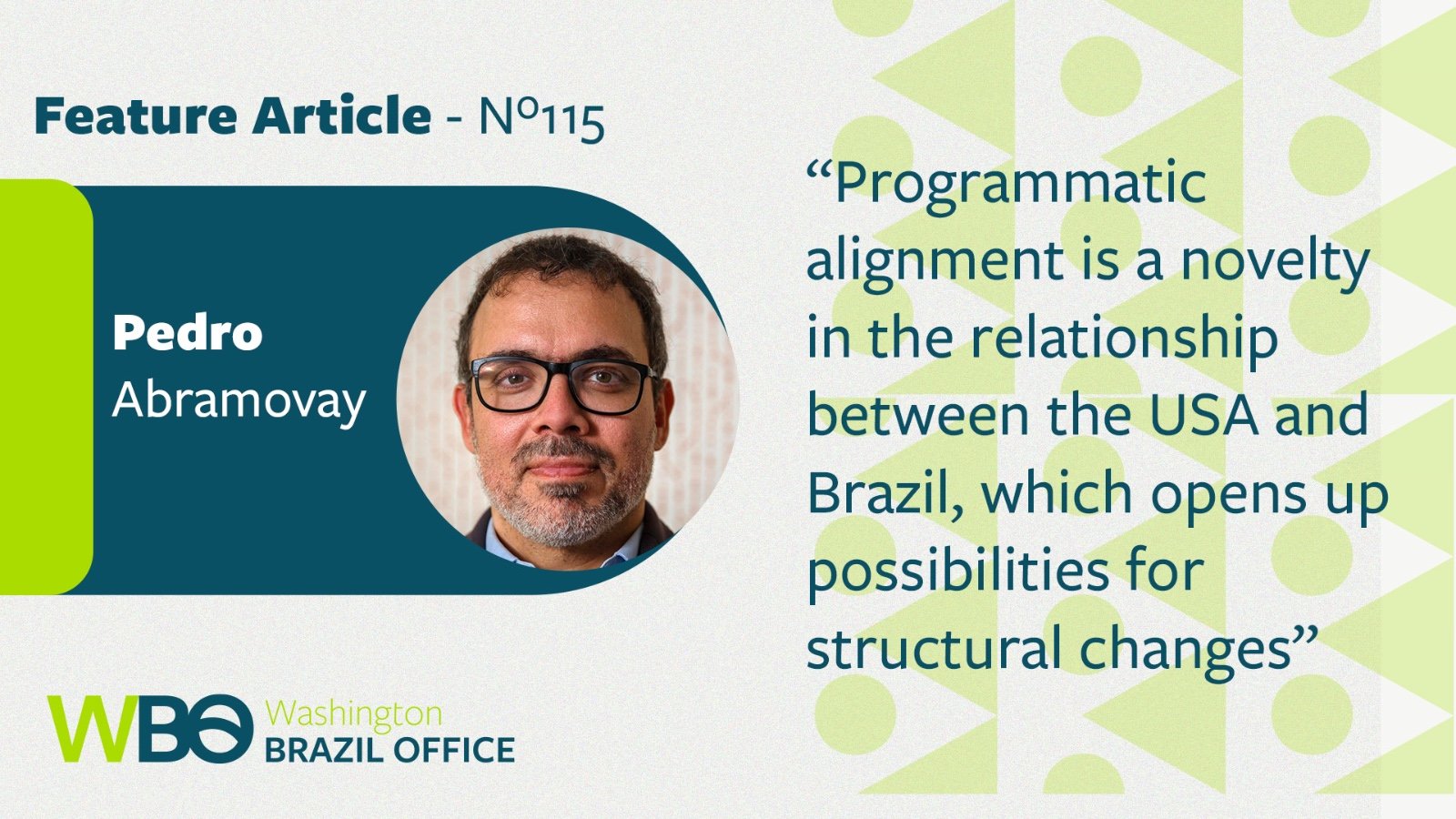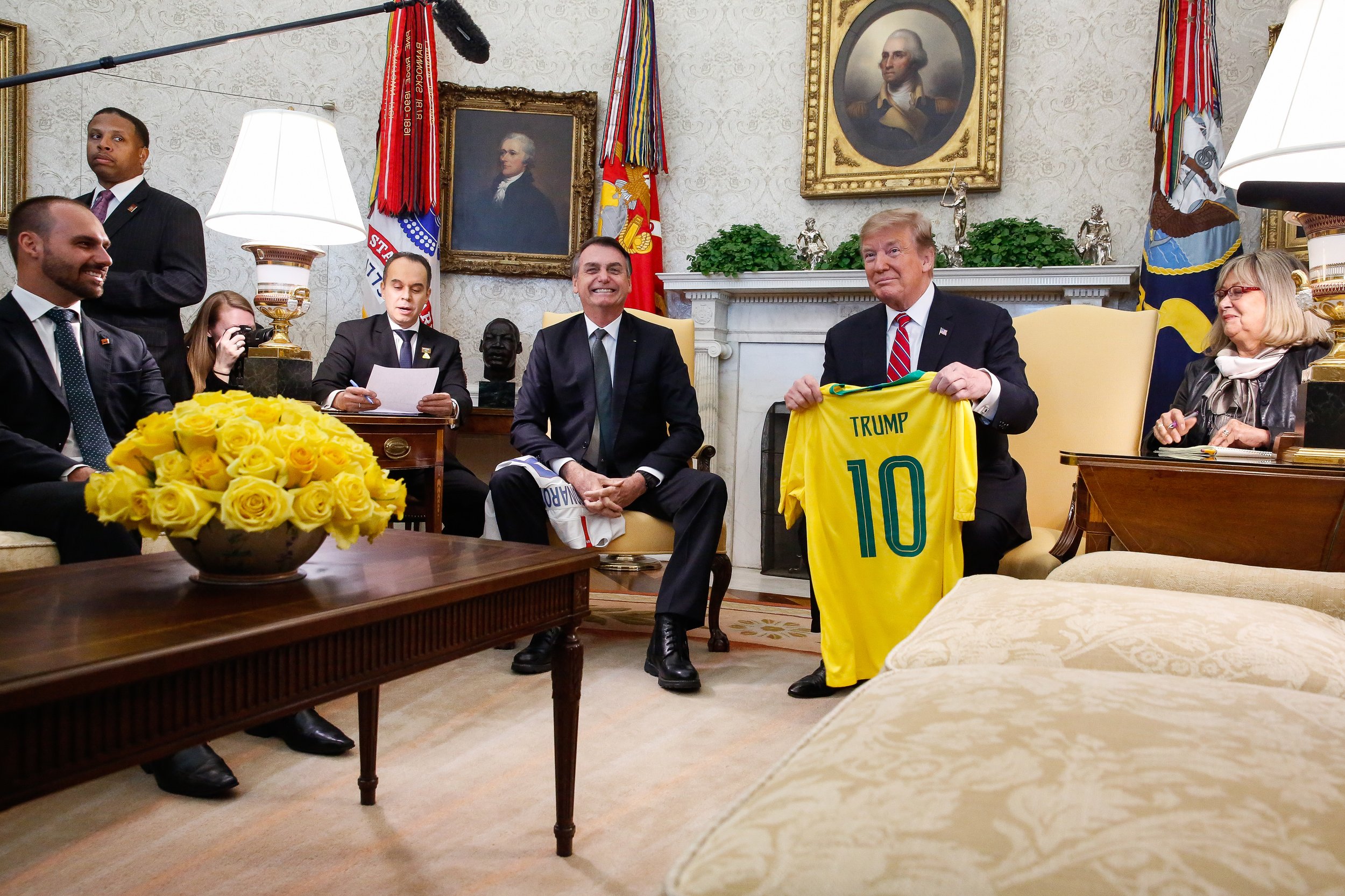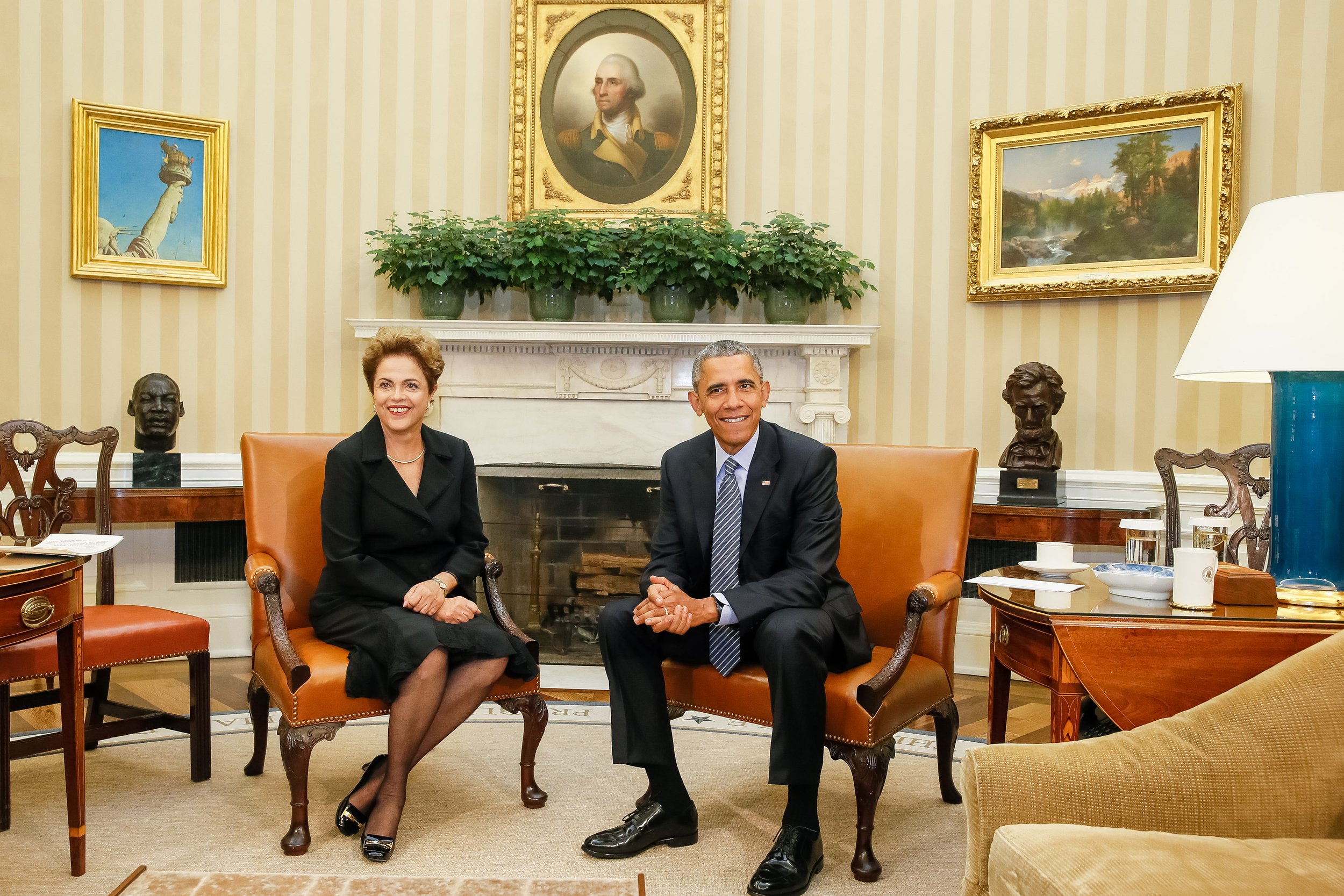Relations between Brazil and the USA: From Pragmatic Alliances to Programmatic Alignments.
Pedro Abramovay, lawyer, doctor of political science from IESP-UERJ and vice-president of the Open Society Foundations. This article was written by Abramovay especially for issue 115 of the WBO weekly newsletter, dated May 3, 2024. To subscribe to the newsletter, enter your email in the field below.
If someone transcribes the debates between Lula and Bolsonaro and between Biden and Trump, translates them into the same language, and erases the authorship of the sentences, it will be difficult, in many instances, to distinguish when it is Lula or Biden and when it is Trump or Bolsonaro who are talking.
The defense of weapons as a solution to combat crime, taxing the super-rich, commitment to the climate issue, the attack on the electoral process, the need for a green industrial policy, climate denialism, the attack on vaccines and lockdown measures in the pandemic: these issues appear in debates in both Brazil and the United States. And we know exactly who defends each of these points in both cases.
Of course, the first thing that might come to mind is a question of style. Absolutely shocking comments, which aim to exude a sincerity that differentiates them from the swamp of politics (even though they emerge precisely from there), are part of the style of both Trump and Bolsonaro. The attack on women (here are two lists of statements offensive to women made by Bolsonaro and Trump) is a way of reinforcing, through toxic masculinity, the image of a strong man that they both cultivate.
On the part of Biden and Lula, style can also bring them closer together. They are older, experienced politicians who try to put the issues that matter to people in simple language. Their proximity to workers and an effort after years of trying to represent a change in politics have led them to play the role of guardians of stability and normalcy.
The similarities of styles between Brazilian and US presidents may not be new. Even though Bill Clinton took office shortly after Fernando Collor, photos of both of them jogging in a t-shirt are famous. And the inspiring speeches of Obama and Lula reconnected their citizens to politics.
But it is natural that presidents can represent the spirit of the times. Therefore, there is nothing very surprising that styles or forms of communication are similar in the United States or Brazil.
What is striking at the current moment, which I will defend here, is something unique in the contemporary history of Brazil and the United States, namely the enormous programmatic alignment between Democrats and the Brazilian center-left on one hand and Republicans and the Bolsonarist extreme right on the other.
The relationship between Brazil and the United States has always been largely pragmatic in nature. What I argue in this article is that we are moving from the possibility of pragmatic alliances to programmatic alliances. And this can have profound consequences – with risks and opportunities – for the countries’ relationship with each other.
Presidents Lula and Biden in New York during the announcement of joint measures on new forms of work for the 21st century
The natural pragmatism in the relationship between the USA and Brazil was never reflected in a true alignment in the political situation of the two countries. In other words, this idea that the two poles of American politics were so similar to the two poles of Brazilian politics, as we see today, did not occur in previous moments of this relationship, at least in the last century.
President Getúlio Vargas, after a few years of hesitation, clearly aligned himself with Roosevelt's USA. Indeed, the famous photo of the two leaders in Natal, Brazil in 1943 captures this moment. Despite some similarities between the New Deal and Vargas developmentalism, the alliance that appeared there was clearly pragmatic, linked to the war and what the United States could offer Brazil to join the allies. Neither Vargas nor Roosevelt wanted to govern their countries in the same way, and the opposition to each of them had little in common.
There are also parallels between both Truman and Eisenhower, on one hand, and Dutra, Getúlio, and Kubitschek on the other, since the pragmatism in the relationship lacked programmatic similarity between the political camps. In fact, the great Americanophiles of the period in Brazil were almost always opponents of the conservative National Democratic Union (UDN).
Programmatic divergence perhaps reached its peak in the 1960s, even though there were similar pressures and agitations coming from civil society in both countries. What was good for the United States (democracy, expansion of civil rights and the “war on poverty”) was clearly not reflected in US policy towards Brazil. And it is under the Democratic presidency, which carried out the aforementioned agenda, that the United States decisively supported the military coup in 1964 that overthrew President João Goulart, who was certainly more in tune with these sentiments than the coup plotters who removed him from power with American support.
Throughout the military dictatorship (1964-85), the pragmatic alliance continued, more clearly than ever without any interest in programmatic alignment. Very little of what the generals wanted for Brazil could be thought of as a governmental program in the United States.
Even with the political transition that started in 1985, which occurred at the height of Reagan's neoliberal policy, the programmatic difference between the debate in the United States and Brazil was enormous. And if there is some alignment between the North American right and the Brazilian right during the period when Collor and George H. W. Bush governed, there was certainly no similarity between Collor's opposition, clearly anti-neoliberal, and the Democrats. This divergence becomes clearer when Clinton and Cardoso shared the presidencies at a time of greater programmatic rapprochement between the two governments. But we are talking about the right wing of Brazilian politics (Fernando Henrique Cardoso with his conservative coalition), close to the left camp of U.S. politics in the form of the Democrats.
Lula and Bush built an excellent pragmatic alliance, but with obvious programmatic differences. And Obama, while nodding to themes common to a certain global progressivism, also shared by the Brazilian left, implemented a very conservative economic agenda. Gary Gerstler, Professor of American history at Oxford University and author of the book The Rise and Fall of the Neoliberal Order, classifies President Obama as the last neoliberal president. In fact, the strong presence of an orthodox economist like Larry Summers in the Obama administration shows the gap with what the Workers’ Party governments were like at that time.
Trump receives Bolsonaro in the White House Oval Office in 2019
Trump's emergence marks, as we know, an earthquake in both US and global politics. If throughout the 1990s and 2000s, the great difficulty in American politics was understanding the real difference between Republicans or Democrats, from 2016 onwards this difference became clearer than ever. And, two years after the earthquake in the United States, the tsunami reached Brazil. In 2018, the same idea and the same form seen in Trump appeared in Bolsonaro.
If Hillary and Haddad perhaps didn't seem so aligned, the Lula who appears in 2022 defends agendas very similar to Biden's. The truth is that Biden's speech represents a shift to the left in the Democratic party. Whether through the clearer incorporation of agendas from movements crucial to Trump's defeat, such as the women's and the Black movements in the United States, or through a clear change in the discourse on the role of the State in the economy, Biden is moving far away from the neoliberal vision of public policy. The need for state intervention in responding to the pandemic, the size of the ambitions for a fair energy transition, and, of course, Chinese competition, radically alter the debate on the possibility of industrial policies and a change in the role of the State.
At the same time, the Lula of 2022 brings a much more ambitious discourse about climate change than that presented in previous terms and begins more frequently to incorporate themes linked to gender, race, and diversity. The image of Lula's inauguration, with representatives of various Brazilian minorities walking up the ramp, represents this moment well.
Furthermore, both Lula and Biden experienced coup attempts by their opponents, with violent invasions of the seats of power. The trial of the people involved in these crimes continues to polarize politics in both countries. The disinformation environment encouraged by Trump and Bolsonaro encourages scientific denialism (both on climate and public health issues), creating conspiracy theories, often supported by religious fanaticism, that attack democracy in both the United States and Brazil.
In other words, the moment is not one of pragmatic alignment between the two countries, as we saw happening over the last century. The alignment is, as never before, programmatic. Trumpists and Bolsonaristas, Democrats and Lulistas, have domestic political agendas with similarities never seen in the history of relations between the countries.
But what exactly does this mean? As previously stated, there are risks and opportunities that arise here. The opportunities are clear. The possibility of concrete cooperation in areas that interest both countries, both in protecting democracy and combating disinformation, and in issues of gender or race, are quite obvious. But, even more profoundly, it is in the climate area that a strategic alliance between countries can be considered. Not only in support of reducing deforestation, but in the understanding that public investment is necessary to build economic alternatives to the predatory economy in the Amazon. The United States has historically, especially since Reagan, played an active role in blocking industrial policy initiatives in Brazil. A programmatic alliance can put a stop to this story and build the possibility of a green industrial policy with US support. From a geopolitical point of view, there is nothing better for the United States, considering the objectives of countering the Chinese advance in the region.
But not everything is rosy in the programmatic similarities. The resumption of the defense of industrial policies in the United States represents, in some way, a return to protectionism. And if this is welcomed by the North American trade unions, we know that it could have complicated consequences for Brazilian industry. A programmatic alliance will have to know how to deal with issues like these.
Of course, the biggest risk of this alignment of the two poles in Brazil and the United States is the possibility of that the right might be in power in one country and the left in the other. Thus, the role of the Biden government was important– even though it destabilized the relationship with Bolsonaro's Brazil – to make it clear that the United States would not accept a coup in Brazil. However, a Trump victory could put ideological alignment ahead of possible pragmatic interests and encourage the American extreme right to impose serious difficulties on the Brazilian government.
Barack Obama receives Dilma Rousseff at the White House in 2015
It is also necessary to mention the risk to democracy in both countries in a possible double- return scenario for the extreme right. The possibilities of cooperation to persecute opponents and undermine institutions will certainly be on the agenda.
Finally, it is important to say that programmatic alignment occurs in domestic policies and not in foreign policy, which is commonly where countries meet. The Lula government's positions on Israel, Russia, China, or Iran are quite distant from the US positions. Coordination and rapprochement are possible, and we are seeing this happen in the cooperation of countries in implementing the Barbados agreement on the Venezuelan elections. But there is a considerable risk that the lack of alignment in foreign policy could prevent the two countries from cooperating on domestic agendas.
Programmatic alignment is a novelty in the relationship between the United States and Brazil. This novelty opens up possibilities for structural changes in the conduct of the countries' relationship. These changes, however, do not mean an abandonment of the pragmatic conditions that continued to inform this relationship, but they require new approaches so that both countries can make the most of this new moment.




